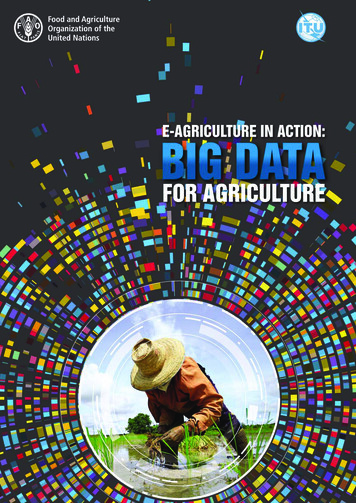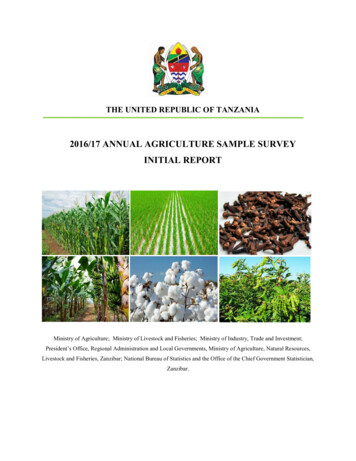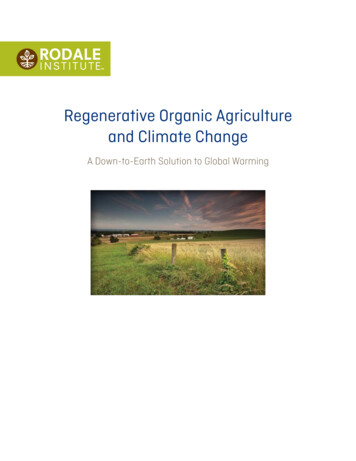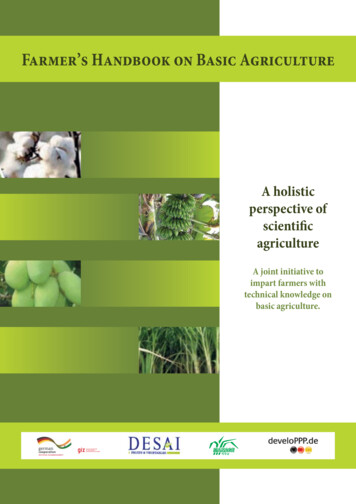
Transcription
Case study: Australia’s agriculture and food sectorFor Australia’s agriculture and food sector, substantial opportunities are emergingfrom Asia’s rise. This will result in a boost to Australia’s economic and socialprosperity, particularly supporting jobs and income in rural and regional communities.National objective19. Australia’s agriculture and food production system will be globally competitive,with productive and sustainable agriculture and food businesses. Australian food producers and processors will be recognised globally asinnovative and reliable producers of more and higher-quality food andagricultural products, services and technology to Asia.Figure C.1: Australia’s agriculture and food sector in the Asian century improve innovation through jointgovernment and industry investmentmanage Australia’s natural resourcebase Chapter 5A productive andresilient Australianeconomy enhance private andpublic engagement inthe regionbuild betterrelationships betweengovernments,industry and thecommunityChapter 6BuildingcapabilitiesAustralia’sagriculture and foodproduction systemwill be globallycompetitive, withproductive andsustainableagriculture and foodbusinessesChapter 9Deeper andbroaderrelationships develop Asia-relevant capabilities inagriculture through education and trainingenhance access to markets in Asiathrough stronger supply-chainmanagement skillsChapter 8Building sustainablesecurity in the regionChapter 7Operating inandconnecting togrowingAsian markets supporting regionaland global foodsecurity through tradeand technical expertise213 reducing tariff andtechnical barriers tofood tradereducing farm subsidiesand export supportsubsidiesstrengthening supplychains through marketaccess and investment
Asia’s demand for food is surgingPopulation and income growth in the region is driving increased demand for food—inquantity, quality and product integrity. The real value of global food demand isexpected to rise by around 35 per cent by 2025 from 2007 levels, with most demandcoming from Asia (Chart C.1). China and India alone could account for almost60 per cent of the global increase (Linehan et. al 2012).The size and scale of global food markets will shift as an increasingly affluent regiondemands higher value food and greater food choice. Consumer food preferences anddiets in our region will change.Chart C.1: Demand for food will growGlobal demand by commodityGlobal food demandVegetables and fruitRest of worldMeatCerealsAsiaDairy productsFishChinaOther foodBreakdownof demandin AsiaIndiaVegetable oilsVegetable mealRest of AsiaFish meal and oil01,0002,000Billion (2007 US )2007202501,000 2,000 3,000Billion (2007 US )4,0002050Source: Linehan et al. (2012).Although Asia contains some of the world’s largest agricultural economies, theprojected increase in consumption in the region will require greater food imports—demand is likely to outpace food production over coming decades based on recentglobal agricultural productivity performance and emerging environmental constraints.The production of agricultural commodities for non-food use—particularlyplant-based biofuels—and non-agricultural uses of land, including urbanencroachment, will also constrain the supply response.Australia’s agriculture and food sector is extraordinarily well-placed to build on itsstrengths: proximity to markets in Asia, complementarity in production systems, arobust biosecurity system, a record of innovation and reputation for producinghigh-quality and safe food products, and a skilled workforce.214
Lifting productivity to increase output and capture value-addingopportunitiesWhile Australia is a relatively small global food producer, we are a reliable exporter ofhigh-quality, ‘clean and green’ agricultural commodities and food products.The sector has emerged from wide-ranging reforms over the past decades moreresilient and competitive. A renewed focus on productivity and investment willunderscore the sector’s next phase of growth.We need to build on the sector’s strengths and build competitiveness through all fivepillars of our productivity agenda—skills and education, innovation, infrastructure, taxreform and regulatory reform, while ensuring we manage our environmental assetssustainably.Through long standing investment in research and development and industryinnovation, Australian agriculture is one of our most productive industries. Wealready encourage innovation across the food value chain through investment in ruralresearch and development corporations, the CSIRO, Cooperative Research Centresprogram and other programs and incentives.By continuing Australia’s strong track record of investment in research anddevelopment, by both government and industry, we can continue to developproducts for Asian markets and solutions to the challenges of production uncertaintyand climate change. The Government is making large investments to supportadaptation through the Securing a Clean Energy Future plan. Better links betweenscientists, researchers and businesses both in Australia and across the region willfurther underpin the application of innovation, science and best practice in the foodproduction and value-adding chain. And the intellectual property that is generated isa growing export opportunity in its own right.Industry investment will be required in response to the opportunities ahead and asnew business models emerge. Access to capital will be essential, and we are creatingthe right operating environment, including through our regulatory and tax reformsand sound macroeconomic policies. Removing unnecessary regulation supportsinvestment and allows industry to transform. Significantly for the agriculture and foodsector we are reforming environmental regulation, undertaking agricultural andveterinary chemical reforms and improving our biosecurity system. Our goal is toplace Australia in the top five countries for ease of doing business.Public and private sector infrastructure investment—especially for transport, energy,communication and water—will be needed. Moving into new areas and methods ofproduction, ensuring that businesses can connect to growing markets, andaccommodating sophisticated logistics requirements—all require careful planning andinfrastructure provision. State and Territory governments, which are responsible forland-use planning, need to ensure that regulation supports, and does not impede,sustainable agricultural development. We will be ensuring that the needs of the215
agriculture and food sector are fully considered in national infrastructure planningand investment.The long-term productivity of agriculture—both here and elsewhere—is tied to thesustainability of food production. Our environmental stewardship is also a source ofcompetitive advantage. We will develop ways to clearly identify our ‘clean, green andenvironmentally friendly’ credentials so that Australian exporters can reap thebenefits of this valuable national ‘brand’.We need to maintain the health of our natural resources, including soil and water,through quality regulation, assisting farmers and fishers to adopt sustainablemanagement practices and through robust markets. The Murray-Darling Basin Planand other water reform policies are critical measures to safeguard the future waterneeds of agriculture, communities and the environment. The Caring for our Countryprogram, which funds management of our natural resources, is another suchmeasure.The boost to the agriculture and food sector’s prospects from Asia’s rise could see thedevelopment of new technologies and practices, as well as the necessary commercialincentives for new infrastructure investment that will enable sustainable productionin northern Australia to flourish.Enhancing capabilities to build successful businessesBuilding Asia-relevant capabilities in the agriculture and food sector will helpproductivity and support deeper connections with our trading partners in Asia. Thesector needs highly skilled people who understand and can respond to the changingdemands of the modern agricultural and food business operating environment andglobal market place.Stronger entrepreneurial, management and technical skills will be necessary to besuccessful in an increasingly interconnected global food industry, and this is placing apremium on partnerships in value chains. The prevalence of multinational foodprocessing and retail companies means our businesses need to show world-classsupply chain management skills, including consistency of supply and the tailoring ofproducts and services to specific market needs. Businesses will need to manage issuesfurther removed from the boundaries of their own operations than ever before.Developing a deeper understanding of the work practices and cultures of countries inAsia will make it easier to build relationships—at the industry and customer levels.Australian businesses will need to understand the diversity of preferences, culturesand circumstances that can affect how products are produced, presented andtransported. This requires strong understanding of the market and capabilities inagriculture and food science and technology.216
Together with industry, we can build the capability and responsiveness of the sector’sworkforce and improve the sector’s attractiveness as a career. We are buildingflexible and high-quality universities and vocational education and training systemsand we have appropriate migration policies. We will ensure that skills and trainingsystems create the pathways that Australia’s agriculture and food businesses need.Through AgriFood Skills Australia, we support industry-led skills agendas andworkforce development in the agriculture and food sector.Industry needs to complement these platforms to build on-the-job training and careeropportunities in the sector.Securing growth through better access to marketsAustralia has a strong record of exporting agricultural and food products—and Asia ishome to many of our largest food markets—as well as a reputation as a leader inagricultural and food technology and science solutions.The Government has recently gained new or improved market access for a number ofproducts to a range of markets in our region, including chilled meat, citrus and tablegrapes to China, and plums and carrots to Taiwan. This builds on existing access toAsian markets. We will continue to work hard to improve market access for ouragricultural and food exports, including ensuring appropriate presence of ouroverseas staff in the region.In cooperation with industry we will work to remove barriers to trade and otherpolicies around the world that are distorting trade and production. Broad-based,multilateral reforms remain our priority. We remain committed to working through allmeans and forums to lower agricultural subsidies and tariff and non-tariff barriers inmarkets, including in the Doha Round of Multilateral Trade Negotiations, whichprovide the best vehicle to achieve open trade. As Chair of the Cairns Group ofagricultural exporting countries, we will continue to lead efforts to secure agriculturaltrade reform in the World Trade Organization.We have successfully concluded a number of free trade agreements, including therecent Malaysia–Australia Free Trade Agreement (MAFTA) which builds on theASEAN – Australia – New Zealand Free Trade Agreement.217
Under MAFTA, Malaysia will guarantee tariff-free treatment for the vast majority ofagricultural products from day one. Key MAFTA outcomes for agriculture and foodexporters include: milk—a liberalised licensing arrangement for liquid milk exporters, allowing accessfor higher value retail products processed foods—immediate elimination of virtually all tariffs wine—a guarantee for Australian exporters of the best tariff treatment Malaysiagives any country rice—open access arrangements from 2023 and all tariffs eliminated by 2026.Our agriculture and food sector is set to benefit from agreements we are pursuingwith our trading partners in the region, including China, India, Indonesia, Japan andSouth Korea.Free trade agreements give concrete benefits and help agriculture and food exportersto compete on equal terms. The comprehensive Trans-Pacific Partnership Agreementand the Regional Comprehensive Economic Partnership have the potential to providecomplementary pathways towards the goal of a free trade area of the Asia–Pacific,which would see tariffs with some of our most significant trading partners eliminated.We will continue to provide a range of support to our agriculture and food businesseslooking to capture opportunities. The Australian Trade Commission (Austrade)distributes trade opportunities to potential Australian suppliers and provides a rangeof market entry services. Austrade also works closely with industry bodies oninternational marketing and promoting awareness of Australia’s high-quality goods—for example Wine Australia (for wine) and the Australian Industry Group (for food andbeverages). Recent legal recognition by China of the Australian Made, AustralianGrown country of origin symbol will provide additional benefits for our exporters offood and beverages to that market.Australia’s policy on foreign investment encourages investment and ensures thatinvestments are in the national interest. We will continue to welcome foreigninvestment in our agriculture and food sector, as we have done in the past. Foreigninvestment provides much needed capital for expansion and supports marketdevelopment and access, customer insights, and the transfer of technology andmanagement skills.Austrade is working with government partners to develop strategies to attractproductive foreign investment into Australia’s agriculture and food sector. Investmentin agricultural research and development is one element of the AustralianGovernment’s inward investment priorities on innovation. A further priority onagricultural science and food technology and processing is currently being exploredwith State and Territory governments. And we will continue to push for lower barriersfor Australian companies that wish to invest overseas. Two-way investment flows willhelp Australian businesses develop value-adding activities, build strong connections218
with markets, and form strong partnerships in increasingly sophisticated andintegrated food value chains.Increased trade will require continued investment in our border controls to buildcapacity and manage biosecurity risks. We are reforming our biosecurityarrangements to deliver a modern system that is responsive and targeted and coversthe entire biosecurity continuum (offshore, at the border and onshore). Moving to aneven more collaborative approach with our trading partners will ensure that risks areidentified and better known before products reach Australia. This will allow Australiato efficiently and effectively respond to our changing risk profile and to the growingpressures on the system. As biosecurity arrangements in Asia mature, we shouldjointly manage biosecurity risks through increased recognition.Maintaining the integrity of Australia’s pest and disease status, through a science andrisk-based approach to biosecurity, will remain vital to safeguarding our environment,our people and the competitiveness of our agricultural and food sector.A shared interest in food securityFood security is at the heart of social and political stability in our region. Asproduction increases lead to scarcer land and water, concerns about food securityand poverty alleviation will rise.We are confident that policy reform in the region and globally will support foodsecurity through the development of efficient and resilient food markets, willstrengthen food-supply systems, and will allow food to move from where it can beproduced efficiently to where it is most needed.We will continue to be active in institutions that support trade, productivity andmarket-oriented development assistance, including the World Trade Organization,United Nations Food and Agriculture Organization, the World Bank, and the AsianDevelopment Bank. We will also draw on APEC’s strengths in trade and investmentliberalisation to advance the food security of our region. Our role in the Group ofTwenty (G20) is an important way to maintain momentum on global and regionalfood security policy.Lifting production capacity and improving distribution infrastructure is a regionaland global task. Australia has much to offer in policy development and throughcollaboration in science and research, in areas such as animal and plant healthand biotechnology, production practices, natural resource management andremediation, logistics and product safety. The Australian Centre for InternationalAgricultural Research is an important channel through which we build networks andshare our research capabilities with the region. The Indo–Australian program onmarker-assisted wheat breeding is an example of Australia working with partners onproblems of mutual interest and is co-funded. The program associates key Indian andAustralian institutions involved in wheat research in a suite of collaborative projects.The program has entered into its fifth year, and an extension for another five years isbeing finalised.219
The Australian and Chinese governments are conducting a ground-breaking jointstudy on cooperation on food security. The study focuses on the potential forinvestment in new productive capacity in the agriculture sectors of Australia andChina to be available for sale on world markets. It would also involve the applicationof research and development and technology on a commercial basis to raiseagricultural productivity in both countries. This includes looking at opportunities inagricultural services and throughout the agribusiness supply chain generally.The objective of this study is to establish a best-practice approach to food securitycooperation between Australia and China that will lead to improved policycoordination across all levels of government to provide consistent advice to potentialinvestors and to avoid regulatory duplication, in line with Australia’s regionaldevelopment goals. It will also assist investors to better understand the requirementsof good corporate citizenship.We are also working in partnership with countries in the region to improvebiosecurity arrangements and animal and plant health systems. These partnershipswill support food security by mitigating risks to production across the region andproviding greater confidence in the trade of food.Building relationships in the regionAchieving liberalisation of agricultural trade through formal trade negotiations is animportant aspect of the Government’s support for the growth of Australia’sagriculture and food sector, but it is not the only aspect. We will also support thesector’s growth through diplomacy, buttressed by industry expertise and partnershipsin the region. Australia’s strong diplomatic and business-to-business relationshipsunderscore our position as a reliable supplier of ‘clean and green’ food products.Knowing the region well helps us understand our neighbours and work with them toidentify new opportunities and build confidence in our products. To developsuccessful commercial links, it is essential that Australian agriculture and foodexporters know what their customers want. We will work with industry to identify theemerging food needs of Asia and develop strategies to help Australia’s exportersrespond to those needs.Strong relationships also support a consistent and ongoing dialogue to manage issuesas they arise. Our in-country presence will continue to be important for clarifying andresolving trade issues and negotiating access, as will achieving more consistent andbetter aligned standards in the region and globally.Our businesses, communities and institutions involved in agriculture and food need tonurture and strengthen their links with the region. People-to-people links across thespectrum—for example, between winegrowers in Australia and emerging winegrowing areas in Asia, scientists working on collaborative research projects, consumeradvocates encouraging consistent food labelling laws, and connecting the experiencesof tourists—will be increasingly important for raising the profile of what Australia hasto offer.220
Leadership and strong policy frameworks are essentialBy managing productive resources sustainably, raising productivity and securingaccess to markets in Asia, Australia’s agriculture and food sector is embracing theAsian century and can look to the future with confidence. Australia is well placed tocapture a healthy share of growing markets, despite fierce competition.Australia can build a food system that is globally competitive and offers reliable,high-quality food products. At the same time, Australia can be an important partner inbuilding food production capacity in our region.The Government’s forthcoming National Food Plan, Industry and InnovationStatement and National Research Investment Plan, as well as our Rural Research andDevelopment Policy Statement, Food Processing Industry Strategy Group and ongoingtrade negotiations, are all significant steps in achieving these goals.Our agriculture and food sector will be transformed by the changes occurring in Asiaand, if industry and governments make the right choices, will be a strong, resilient andflexible part of the Australian economy, reinforcing the confidence we have in ourown food security.The mechanisms outlined in this White Paper, through partnership across industry,government and the broader community, lay the ground work on which to build amore integrated and productive food sector in the region.221
Commonwealth of Australia 2012ISBN978-1-921739-92-7 (print)978-1-921739-93-4 (PDF)978-1-921739-94-1 (HTML)Ownership of intellectual property rights in this publicationUnless otherwise noted, copyright (and any other intellectual property rights, if any) in this publication isowned by the Commonwealth of Australia (referred to below as the Commonwealth).Creative Commons licenceWith the exception of the Coat of Arms; photographs; charts 1, 1.1, 1.3, 1.4, 1.6–2.8, 2.10, 2.12–3.2, 3.5,A.1–A.4; figures 2.1 and 2.2; and Box 4.3, this publication is licensed under a Creative CommonsAttribution 3.0 Australia Licence.Creative Commons Attribution 3.0 Australia Licence is a standard form license agreement that allows youto copy, distribute, transmit and adapt this publication provided that you attribute the work. A summaryof the licence terms is available from .en. The fulllicence terms are available from lcode.The Commonwealth’s preference is that you attribute this publication (and any material sourced from it)using the following wording:Source: Licensed from the Commonwealth of Australia under a Creative Commons Attribution3.0 Australia Licence.The Commonwealth of Australia does not necessarily endorse the content of this publication.Use of the Coat of ArmsThe terms under which the Coat of Arms can be used are set out on the Department of the PrimeMinister and Cabinet website (see www.dpmc.gov.au/guidelines).Contact usInquiries regarding the licence and requests to use material in this document are welcome at:Australia in the Asian Century Implementation Task ForceDepartment of the Prime Minister and CabinetPO Box 6500Canberra ACT 2600Email: asiancentury@pmc.gov.au
Case study: Australia’s agriculture and food sector For Australia’s agriculture and food sector, substantial opportunities are emerging from Asia’s rise. This will result in a boost to Australia ’s economic and social prosperity, particularly supporting jobs and income in










